#bujo account
Explore tagged Tumblr posts
Text

Gone Pissing - available as stickers and acrylic keychains soon!
#digital art#drawing#digital illustration#stickers#sticker business#sticker bomb#artists on tumblr#M.2 Designs#silly goofy#artwork#my art#say no to ai art#gone pissing#stay hydrated#hydrate or diedrate#remember to hydrate#bullet journal#bujo#washi tape#digital painting#aesthetic#groovy#groovy aesthetic#aesthet#small artist#small art account#small art blog#small art business
19 notes
·
View notes
Text

Created my Autumn Bucket List! Have you created yours yet?
#art#artists on tumblr#small art account#cute art#my art#bullet journal#bujoinspo#bujo spread#bujo#autumn vibes#autumnal#autumn#fall#autumn aesthetic#fall vibes#autumn bucket list#fall bucket list#journalling#journaling#journal#journal entry#planner#planning
17 notes
·
View notes
Text





Confessions of a Sugar Addict
I realised a number of years ago that I have a real problem with regulating my intake of sugar: that I am pretty addicted to the stuff. A few years ago I weened myself off the processed stuff, and went a few years having almost no processed sugar at all.
The calendar above shows my sugar intake for this year. Most days that I have eaten processed sugar in some form, i added a 🍭 entry in my Progress Journal app.
This month is shaping up to be the month I am eating the most sugar all year. Today I ate two cakes, and a cookie, when I was meant to be getting back on track.
There is usually (but not always) a correlation with emotional eating and the sugar consumption. This is certainly the case most recently.
I had been hoping to introduce more processed sugar into my diet, but its clear I have veered too much into the craving and binging pattern. This is of course disrupting my fat loss goal.
So I am going to go cold turkey again. Luckily I have done this a number of times, and whilst its not easy, I know the protocol that works for me.
The next post will detail that protocol.
1 note
·
View note
Text
Best Robotics Papers in 202

What Are the Best Robotics Papers?
The field of robotics is rapidly evolving, with groundbreaking research and innovative developments happening at an unprecedented pace. For those deeply entrenched in this field or simply curious about the latest advancements, understanding the most influential and highly-regarded robotics papers is crucial. This article delves into some of the best robotics papers that have significantly contributed to the field, highlighting their key findings, methodologies, and impacts.
Introduction to Robotics Research
Robotics research encompasses a wide array of topics, from artificial intelligence and machine learning to mechanical design and human-robot interaction. Each of these areas contributes to the overall advancement of robotics, making it a multidisciplinary field that requires a comprehensive understanding of various scientific principles and technologies.
Key Areas of Robotics Research
Artificial Intelligence and Machine Learning
AI and machine learning are at the heart of modern robotics, enabling robots to perform complex tasks, learn from their environment, and adapt to new situations. Some of the most influential papers in this area include:
"Mastering Chess and Shogi by Self-Play with a General Reinforcement Learning Algorithm" by Silver et al.
Summary: This paper introduces AlphaZero, an AI system that uses reinforcement learning to master chess and shogi without prior knowledge of the games.
Impact: Demonstrates the power of reinforcement learning in developing AI that can learn and outperform humans in complex tasks.
"DQN: Playing Atari with Deep Reinforcement Learning" by Mnih et al.
Summary: The paper presents a deep Q-network (DQN) that combines reinforcement learning with deep neural networks to play Atari games at a superhuman level.
Impact: Showcases the potential of deep learning in developing AI agents capable of complex decision-making processes.
Mechanical Design and Control
Mechanical design and control are fundamental to the development of efficient and functional robots. Notable papers in this domain include:
"Passive Dynamic Walking" by McGeer
Summary: This pioneering work introduces the concept of passive dynamic walking, where robots use gravity and inertia to achieve efficient, human-like gait patterns without active control.
Impact: Revolutionizes the approach to robotic locomotion, emphasizing energy efficiency and simplicity.
"BigDog, the Rough-Terrain Quadruped Robot" by Raibert et al.
Summary: Describes the development of BigDog, a quadruped robot capable of navigating rough terrain using advanced control algorithms and mechanical design.
Impact: Advances the field of legged robotics, showcasing the potential for robots to operate in challenging environments.
Human-Robot Interaction
Human-robot interaction (HRI) is a critical area of research, focusing on how robots and humans can work together effectively. Key papers in this field include:

Breakthrough Robotics Papers
"Planning Algorithms" by LaValle
Summary: This comprehensive book covers a wide range of planning algorithms essential for robotics, including motion planning, discrete planning, and planning under uncertainty.
Impact: Serves as a foundational reference for researchers and practitioners in the field of robotics planning.
"Probabilistic Robotics" by Thrun, Burgard, and Fox
Summary: Introduces probabilistic methods for robot perception, localization, and mapping, emphasizing the importance of uncertainty in robotic systems.
Impact: Establishes a new paradigm in robotics, where probabilistic approaches are integral to developing robust and reliable robots.
"The DARPA Robotics Challenge Finals: Humanoid Robots To The Rescue" by Pratt et al.
Summary: Details the DARPA Robotics Challenge, a competition aimed at developing humanoid robots capable of performing complex tasks in disaster response scenarios.
Impact: Highlights the advancements and challenges in creating humanoid robots that can operate in real-world disaster situations.
Emerging Trends in Robotics Research
Swarm Robotics
Swarm robotics involves the coordination of multiple robots to achieve collective behavior. Key papers include:
"Swarm Intelligence: From Natural to Artificial Systems" by Bonabeau, Dorigo, and Theraulaz
Summary: Explores the principles of swarm intelligence and their application to robotics, drawing inspiration from natural systems like ant colonies and bird flocks.
Impact: Provides a comprehensive framework for understanding and developing swarm robotics systems.
"Kilobot: A Low-Cost Scalable Robot System for Demonstrating Collective Behaviors" by Rubenstein et al.
Summary: Introduces Kilobot, a low-cost, scalable robotic system designed to study collective behaviors in large robot swarms.
Impact: Demonstrates the feasibility of large-scale swarm robotics and its potential applications.
Soft Robotics
Soft robotics focuses on creating robots with flexible, deformable bodies that can adapt to their environment. Influential papers include:
"Soft Robotics: A Bioinspired Evolution in Robotics" by Laschi and Cianchetti
Summary: Discusses the principles and applications of soft robotics, inspired by biological systems like octopuses and worms.
Impact: Highlights the potential of soft robots in areas where traditional rigid robots are limited.
"Soft Robots for Chemists" by Whitesides
Summary: Explores the interdisciplinary nature of soft robotics, particularly its applications in chemistry and biomedical engineering.
Impact: Bridges the gap between robotics and other scientific disciplines, fostering innovation and collaboration.
Conclusion
The field of robotics is a dynamic and rapidly evolving area of research, driven by groundbreaking papers that push the boundaries of what is possible. From AI and machine learning to mechanical design, human-robot interaction, and emerging trends like swarm and soft robotics, these papers have laid the foundation for the future of robotics. By understanding and building upon these seminal works, researchers and practitioners can continue to advance the field, creating robots that are more intelligent, capable, and adaptable than ever before.
If you want to read more information about how to boost traffic on your Website just visit PRAGROBOTICS.
#robotics#100 days of productivity#academia#artificialintelligence#artificial intelligence#audi#accounting#bujo spread#bmw#autos#Pragrobotics
0 notes
Text
Making this my bujo blog now!
Moving my to here for my studyblr!
#like/reblog if ur a studyblr/bujo account#studyblr#studysthetics#bujo#bullet journal#bullet journaling#journaling#art#doodle#doodling
7 notes
·
View notes
Text
Your Reading Journal

Reading journal - (also called a book journal) the perfect way for students and book lovers to keep a record of the insights, observations, and lessons they've learned from reading.
A reading journal can also double as a book log—including a list of books and relevant summaries—to help readers stay on top of their reading goals.
You don't need anything fancy to start a reading journal.
A simple lined, blank, or dotted journal will do just fine.
Just be sure you have the right number of pages to last you all year.
How to Keep a Reading Journal
Consider these reading journal ideas for keeping your own reading journal.
Use a small journal for easy transport. Instead of opting for a larger journal, opt for a small, pocket-size journal that you can easily stash in a pocket or handbag for on-the-go journaling.
Track the types of books you’ve read. Keeping a book tracker or reading log is helpful for keeping track of your reading habits, revealing whether you’re more into mysteries, thrillers, historical non-fiction, or novels.
Stay on top of reading goals. Keeping a reading tracker is all about being able to measure your progress and keep yourself accountable to a reading challenge. Keeping a list of the books you've read will help you gauge whether or not you're on track to beat last year's goals.
Keep notes to write book reviews. When you finish a new book, consider writing a review. Whether it be a short synopsis, star rating, or lengthy critique, writing down notes as you read the book is a helpful method for remembering how it struck you. This is especially helpful for members of a book club who may be pressed later to give their opinion of the book.
Keep a list of your favorite books. Avid readers could benefit from keeping a section of their reading journal devoted to listing their favorite books of the year. This way, at the end of the year, you'll have a convenient way to find more books that you’ll likely be interested in exploring.
Leave room for doodles. Sometimes inspiration is more easily captured by drawings than words. Leave some room in your reading journal for drawing doodles to help you process the reading in a new and unexpected way.
Personalize your journal. When starting a reading journal, add some personal touches to keep your journal interesting to you. Washi tape comes in a wide variety of colors and patterns, and it won't damage your journal pages. Adorning the front of your journal with stickers is a great way to add a little color to your bookshelf.
How to Organize a Reading Bullet Journal
A bullet journal (BUJO) - a journal specifically formatted to suit your unique journaling goals.
As such, it will take some effort on your part to set up your bullet journal spread.
Purchase a blank page or dotted journal, and use markers or pens to organize it to your liking.
Consider organizing it by month and creating checkboxes for each book you wish to read in a particular week.
Create a section at the end of each week to jot down your impressions of the book, leave a review, or assign it a star rating.
Unlike planners, BUJOs are not dependent on the calendar year and can be started at any time.
Source ⚜ More: References ⚜ Journal Writing ⚜ Writing Resources PDFs
#journal#reading#writeblr#studyblr#bookblr#writing inspiration#writing ideas#writing exercise#literature#writers on tumblr#writing reference#writing prompt#spilled ink#booklr#creative writing#books#thomas eakins#writing resources
116 notes
·
View notes
Text


29|11|2024
I decided to bring back my self care lists. I don't really have a structured plan yet, bc it was a decision I made without much thought, but to start I think I'll try to be mindful each day by doing at least three things that can count as self care, and then write them in my daily posts to hold myself accountable. No matter how small they are they count as long as I am doing something to make myself feel better. I am going through an emotional time and I need to be extra careful with myself, and since this is a low effort thing that worked in the past it seems like the right way to go.
today's productivity:
read first thing in the morning
wrote and posted a book review of the book I finished (I haven't posted one in ages it was nice to write one again!)
continued rewriting the second set of notes for my political institutions class
duolingo
worked a bit on my reading journal and set up my bujo for December
today's self care:
set my alarm a bit later than usual
finished studying earlier than usual both in the morning as well as in the afternoon because if brain isn't braining I don't see why I should torture myself and struggle when I clearly need rest
started relistening monstrous agonies and spent my entire lunch break listening to it (I need the sort of comfort that podcast gives me and it was truly needed)
📖: The Forbidden Harbor
🎵: Mayday by Three Days Grace
#studyblr#studyinspo#uniblr#university#self care#studying#productivity#journaling#journal#knife gang#mine#the---hermit
28 notes
·
View notes
Text
absolutely devastating brah
i come back here to find out that bujo moss and lesbian mind flayer have deactivated their accounts
#is life worth living now??#i need my theories and my art#y'all better tell me what happened#stranger things#st5#byler
21 notes
·
View notes
Note
This may be a strange question, but as someone who has never gotten the hang of using notebooks in my day to day life (unless it's once in a while to outline something specific like a project for work), what are the kinds of things you write down in them?
for journaling, that's complicated. youtube always recommends me these "journaling will improve your life!" videos and i think they're very funny because i've kept a journal for 20 years and it has made me a worse and more miserable person. so i will not be writing any "how to journal" posts any time soon.
my commonplace notebook, however, is where i keep everything. every morning i write down the date, the hours i slept, and my weight. occasionally i track my mood and mental state, because when i meet with my psychiatrist i like to have cold hard data to give her. then beneath that, i write out my to do list for the day.
it's kind of a reverse bullet journal in that you fill it up with all the random ephemera of your life and then label the important bits with a highlighter and index it later.
more specifically i keep:
the books/movies/shows/etc that are recommended to me.
notes i take at the doctor's office, or when i do my taxes, or get my oil changed. i'm a compulsive note-taker. in fact i started a commonplace notebook because it calms me to have something to write on and with even in situations where that's weird. i'd rather look weird than be anxious.
ideas for fanfic, original work, newsletters, craft thoughts, workshop models, etc.
brainstorming/planning/prewriting stories.
tracking my WIP cleanout and annual goals.
doodling!
i think sometimes we get caught up in building spaces for things to keep them organized, like that's the whole point of bujo. you create a page layout to do a specific function and then you fill it out. but that doesn't account for the stuff you haven't made a page for, stuff that would be blight in a bujo. we also think that a whole page needs to be devoted to a specific thing, or a notebook needs to be devoted to its subject. but you an also just...not do that.
it's a lot of work to setting up a bujo. work i would love to have the energy and aesthetic inclinations to do. but i don't. so i do the next best thing which is fill up every page in the most chaotic way possible.
poorly scanned example pages under the cut:

these are notes i took during my rewatch of Mockingjay in preparation of writing Wind of the New World.
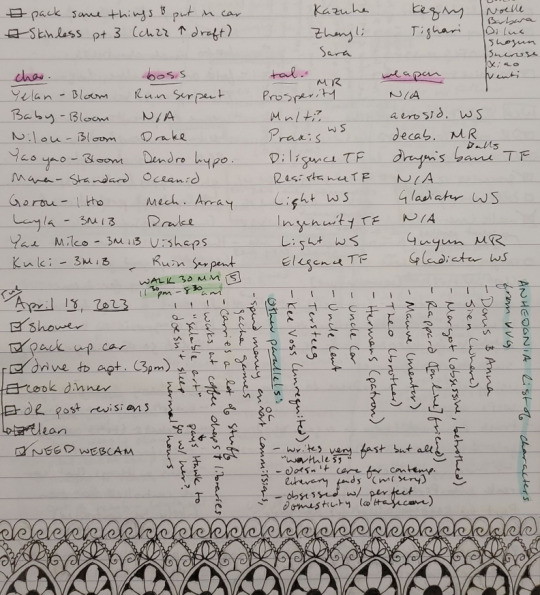
notes about leveling my Genshin team, and notes about a story i was working on. and a to do list.
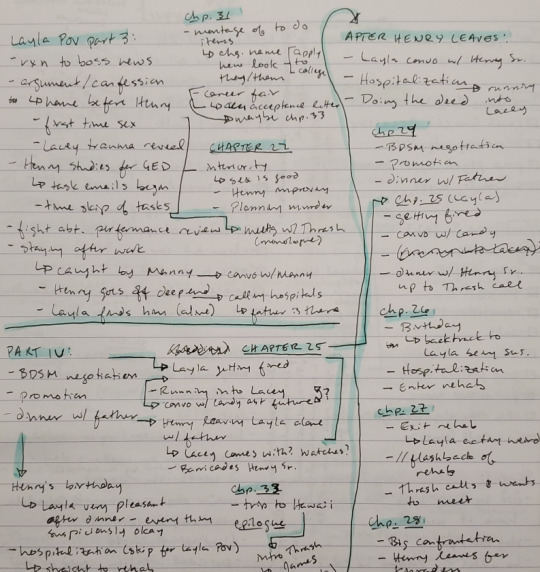
working through a plot knot in Skinless.
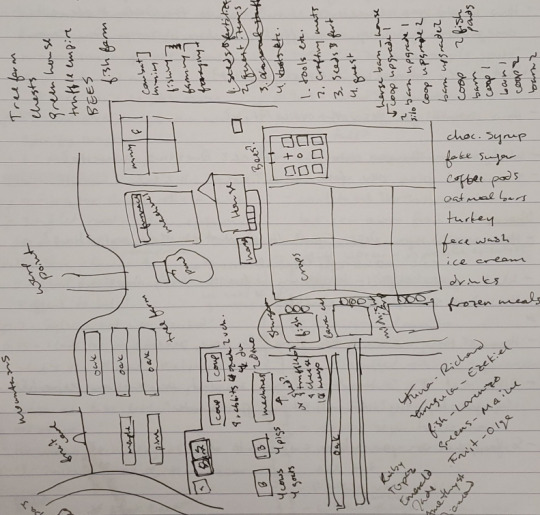
Stardew Valley farm planning. and a grocery list i think.
i don't recommend this method for everyone. i think if i were to have read this post 2 years ago my thought would be, "what the fuck is wrong with you." but it works for me and makes me happy, and as long as all the important information is safely indexed and retrievable, it doesn't matter how messy the pages get.
51 notes
·
View notes
Text
Sharing my story and why I'm passionate about bullet journaling.
It was the year 2020 when the pandemic hit. While other people found love in making Dalgona coffee and growing plants, I discovered and became enthusiastic about bullet journaling after I saw a pen collection post on Facebook. I followed the profile and fell down the rabbit hole of stationery and journaling (and planning, too!).
I didn't know it was a thing that's been going on for years. I wrote diaries when I was a child up to my teenage years but have always stopped. The longest time I journaled was a year until the diary was stolen. At other times, I eventually got lazy and missed writing diary entries until I stopped altogether.
Discovering bullet journaling changed how I journal and has helped me constantly write since 2020. Sure there were backlogs, which even lasted for 2-3 months but I always keep coming back. I found myself passionate about what I do. The added creativity challenge makes it delightful to me.
One main reason why I pursued this hobby is because I was really desperate to find a way to lessen my screen time. Illustrating and decorating helps me stay away from gadgets and focus on things that matter more.
Today, I run a Facebook page and TikTok account where I share my journal spreads. (Not just bujo but creative diary as well!) You may also join my Facebook group if you need help from fellow journaling enthusiasts. I'm hoping to see you there!
#bujo#bulletjournal#bujo aesthetic#100 days of productivity#creative journaling#planning#stationery#stationeryaddict
12 notes
·
View notes
Text
Hello 👋🏻 I'm KNV! I'm a writer and visual artist. This account features both my original work and fanworks for my eternal hyperfixation: ff7!
Disability, chronic pain, narrative medicine, grief, and class are subjects inseparable from my work, and you'll find those ideas weaved into just about everything I make. I primarily write prose, in science fiction/speculative fiction/science fiction fantasy genres (SF/SFF), as well as creative nonfiction essays.
You can't find my website here, though it's (always) desperately in need of an update. If you're just here for the fanfiction, here's my A03. x
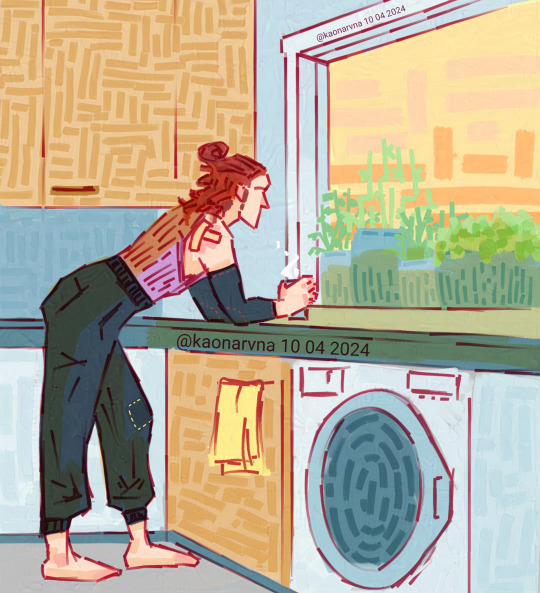
「 a "pretty" self portrait — for once 」
Some helpful tag-links:
My Art 🌿 Original Writing 🌿 Fanfiction 🌿 EDS Posting 🌿 BUJO Sketch Dumps 🌿 Misc. Personal Posting 🌿 WIP Posting 🌿 Decision Polls 🌿 Request and Commission Information 🌿
Finally——I don't bite! The ask box is open, and if we're mutuals, so are my DMs. Feedback of all varieties is always appreciated. Or, if you think you've found something I'd enjoy, you're more than welcome to send it my way. Thank you for taking a moment to look at my work, I appreciate it.
10 notes
·
View notes
Text
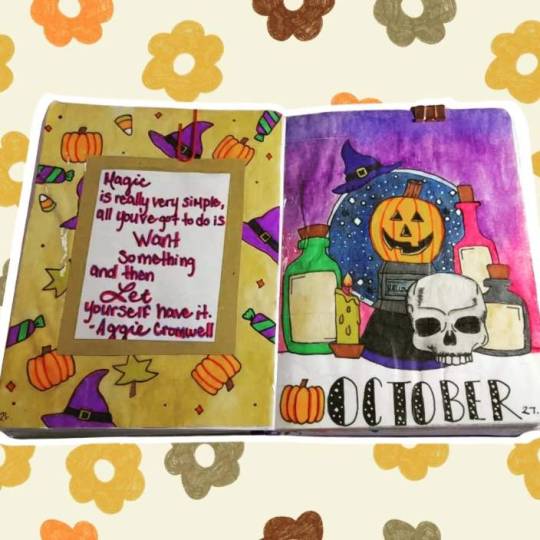
October Bullet Journal Spread - 2020
#art#artists on tumblr#small art account#cute art#illustration#my art#halloween art#october#bullet journal#bujoinspo#bujo spread#bujo#planner#notebook#journalling#journaling#journal#planning#artwork#art style#traditional art#traditional illustration#watercolor#watercolour art#watercolourpainting#watercolour illustration#traditional media#watercolor painting#traditional painting#painting
7 notes
·
View notes
Text
A Robotics Operating System: Simplifying Robot Software Development
Robotics Operating System
A Robotics Operating System (ROS) is a flexible framework for writing robot software. It is a collection of tools, libraries, and conventions aimed at simplifying the task of creating complex and robust robot behavior across a wide variety of robotic platforms. Here are some key aspects of ROS:
Key Features of ROS
Hardware Abstraction: ROS provides a standard interface for hardware components, making it easier to switch between different hardware without changing the software.
Device Drivers: ROS includes a collection of drivers for commonly used sensors and actuators, allowing developers to focus on higher-level functionality.
Communication Tools: ROS enables different parts of a robot system to communicate using messages. It supports peer-to-peer communication, which helps in distributing processing loads.
Libraries and Tools: ROS comes with a wide range of libraries and tools for tasks like visualization, simulation, and debugging.
Modularity: ROS is designed to be modular, which means you can build and use only the components you need. This makes it easier to develop, test, and deploy robotic applications.
Components of ROS
Nodes: These are the processes that perform computation. Each node is responsible for a specific task, and multiple nodes can run concurrently.
Messages: Nodes communicate with each other using messages. These messages can contain sensor data, control commands, or any other type of information.
Topics: Topics are named buses over which nodes exchange messages. Nodes can publish messages to a topic or subscribe to receive messages from a topic.
Services: Services are used for request/reply communication. They allow nodes to send a request to another node and wait for a response.
Bags: Bags are used to record and playback ROS message data. They are useful for debugging and testing.
Popular Versions of ROS
ROS 1: The original version of ROS, which has been widely adopted and used in many research and industrial applications. It provides a comprehensive set of tools and libraries for developing robotic applications.
ROS 2: The next generation of ROS, designed to address some of the limitations of ROS 1. ROS 2 introduces improvements in real-time performance, security, and support for multi-robot systems.
Use Cases of ROS
Research and Academia: ROS is extensively used in research labs and universities for developing and testing new algorithms and robotic systems.
Industrial Automation: ROS is used in industrial settings for tasks like automated inspection, pick-and-place operations, and collaborative robotics.
Service Robots: ROS powers many service robots used in healthcare, hospitality, and domestic environments.
Autonomous Vehicles: ROS is used in the development of autonomous ground and aerial vehicles, providing AI tools for perception, planning, and control.
Getting Started with ROS
Installation: ROS can be installed on various operating systems, including Ubuntu, Windows, and macOS. Ubuntu is the most widely used platform for ROS development.
Learning Resources: There are many tutorials, courses, and books available for learning ROS. The official ROS documentation is a good starting point.
Community Support: The ROS community is very active, with many forums, mailing lists, and social media groups where developers can seek help and share knowledge.
Simulators: Tools like Gazebo and RViz allow developers to simulate and visualize their robotic systems, making it easier to develop and test algorithms without needing physical hardware.
Conclusion
ROS is a powerful and versatile framework that has become a standard in the robotics community. Whether you are a researcher, developer, or hobbyist, ROS provides the tools and resources needed to build sophisticated robotic systems. Its modularity, extensive libraries, and strong community support make it an ideal choice for anyone interested in robotics.
#robotics#artificialintelligence#academia#100 days of productivity#accounting#audi#artificial intelligence#bujo spread#autos#bmw
0 notes
Text
Introduction Post
Hello everyone!
You can call me Bug 🪲
I've decided to make a blog about my life as a nature school/preschool teacher. I will probably post about crafts/lesson plans as well as just random thoughts about educational topics. I also want to try 100 days of productivity at some point, and use this place as a source of accountability to make social goals.
🪲fun facts🪲
🧓 I am 29 🧓
🏴☠️ I am nonbinary 🏴☠️
🌈 I use mostly they/them pronouns but I'm fine with any really 🌈
💀 I am autistic 💀
☯️ I had blue hair up until recently, so I was the most stereotypical blue haired liberal ☯️
🌊 I live by the beach and love the ocean 🌊
🐔 We have chickens at my school (and they're mostly my responsibility lmao) 🐔
📒 I love bujo stuff and will probably post journal spreads 📒
🍃💨 enough said 💨🍃
Thanks ❤️
Bug🪲
#100 days of productivity#bujo#bujoblr#forest school#nature school#preschool teacher#teacher#inro post#nonbinary#lgbtq#lgbtq community#actually autistic#autism#autistic adult
3 notes
·
View notes
Text
FTW I want a Bujo Partner to help me with accountability 😔😔😔
3 notes
·
View notes
Note
The real question is does Paige post her bujo spreads...if she does is it different from her cynic funnyman twitter and does it surprise people deeply to know that's the same Poster
Oh my god you are asking all the right questions.... yes of course Paige posts her bujo spreads but like the ones she posts she neeeeeever uses they are literally just to farm engagement. Her actual daily logs are like insane scribbles that makes whatever the Waxen Scrivener was doing to that guy Abel from ep2 look tame.
I think yeah she has her aesthetic bujo IG and TikTik accountd and her cynical trans funnywoman Twitter account entirely separate and they're not linked and if anyone discovered it was the same person posting both Paige would deny it. Thus is the conflicted nature of her selfhood.
And also I think she has an Ao3 account. Checkmate puriteens but Paige definitely reads (if not writes) Game of Thrones rarepair smut. In my opinion.
18 notes
·
View notes